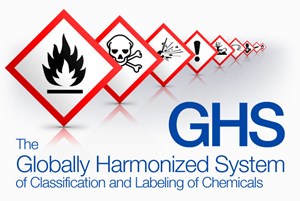LEARN MORE about GHS, Part 3: What Must Be Done to Comply with GHS?
LEARN MORE about GHS, Part 3: What Must Be Done to Comply with GHS?

Globally Harmonized System
©
GHS, or Globally Harmonized System for classification and labeling of chemicals, is already happening. Companies around the world are already deeply involved in compliance. But there is still much to be done before compliance is complete. While there may be slight differences in implementation from country to country, basic requirements are the same worldwide.
Classification of Chemicals to HazCom GHS Criteria
Even if a material was not considered hazardous under the existing system it will not automatically escape classification in the HazCom GHS. HazCom GHS criteria are broader than existing standards. They will capture more materials. All chemicals within each company’s area of responsibility will require review and reclassification.
Preparation of Labels with HazCom GHS Elements
The HazCom GHS has standardized the format of labels so that they all will have the same headings. Standard phrases must be used to describe the various hazards. All existing chemical labels must be reviewed and reformatted to these new standards.
Preparation of HazCom GHS Format Safety Data Sheets (SDS)
HazCom GHS uses the term Safety Data sheets (SDS) instead of Material Safety Data Sheets (MSDS). HazCom GHS-compliant Safety Data Sheets have 16 parts arranged in a standard format with specific information required under each heading and sub-heading. The SDS requirements in Europe are very prescriptive. Companies wishing to do business in Europe are strongly advised to check out European requirements and perhaps adopt those for their SDS preparation world-wide. The 16 main headings on an SDS are as follows:
-
Identification of the substance
-
Hazard identification
-
Composition/ingredients
-
First-aid measures
-
Fire fighting measures
-
Accidental release measures
-
Handling and storage
-
Exposure controls/personal protection
-
Physical and chemical properties
-
Stability and reactivity
-
Toxicological information
-
Ecological information
-
Disposal considerations
-
Transportation information
-
Regulatory information
-
Other information dates/revision
Note that European SDS rules require that the Preparation Date of the SDS and any amendments be at the top of the first page.
Training Employees on New Label Elements and SDS Format
The largest task in HazCom GHS implementation will likely be safety training of employees. The HazCom GHS is more complex than previous hazard communication systems. The three main hazard groups – Physical, Health, and Environmental – are subdivided into various hazard “classes”. Physical =16 classes; Health =10 classes; and Environmental =2 classes. In addition the various classes are subdivided into hazard “categories” depending on whether they are serious hazards or less serious. This complexity requires that any training be carefully planned. In particular the training must be able to turn complex terms and concepts into everyday, understandable language. Programs offering training in several different languages will be in high demand.
This is the third of a four-part series on the new GHS standards.
Part 4: When Will GHS Start?
Back